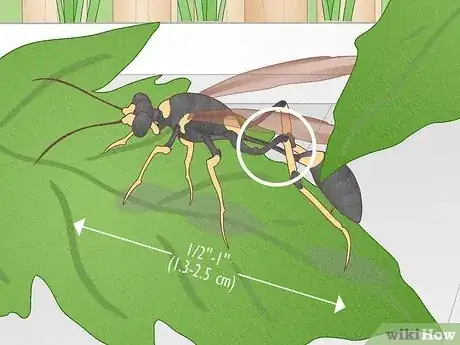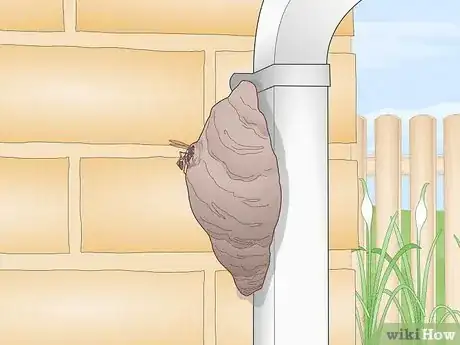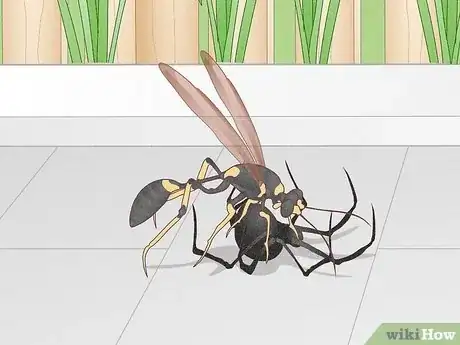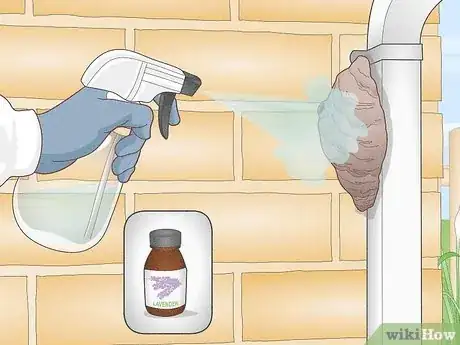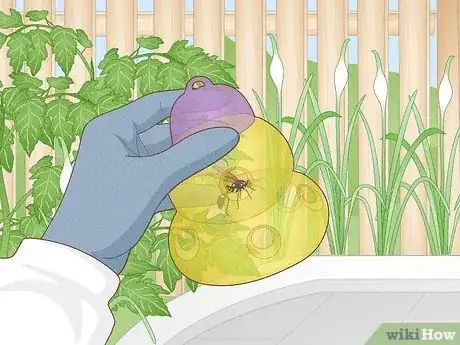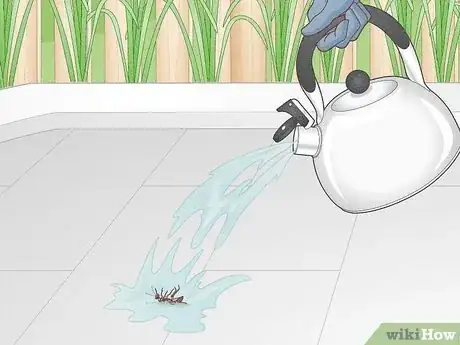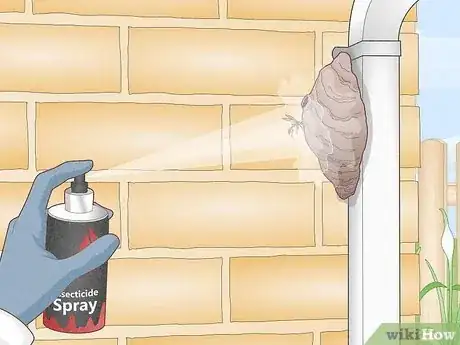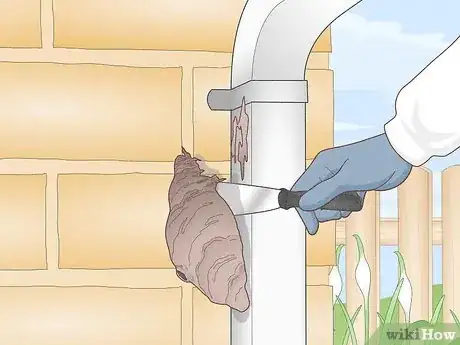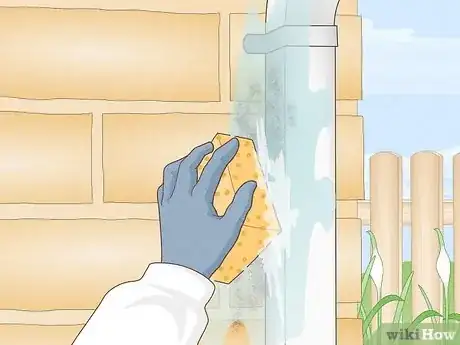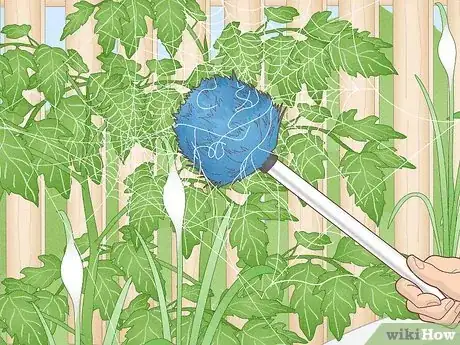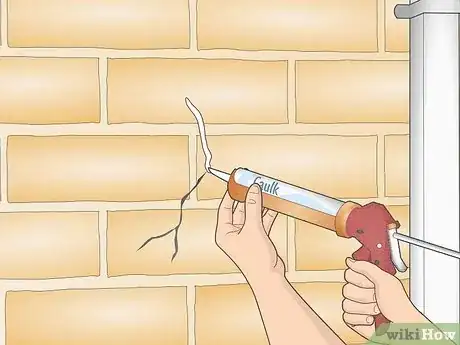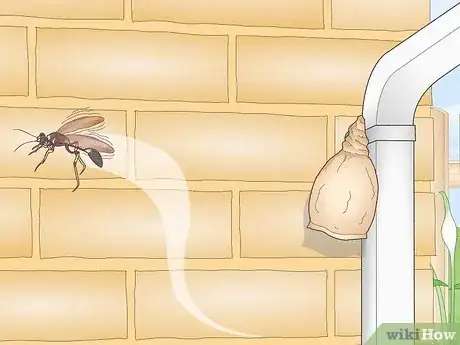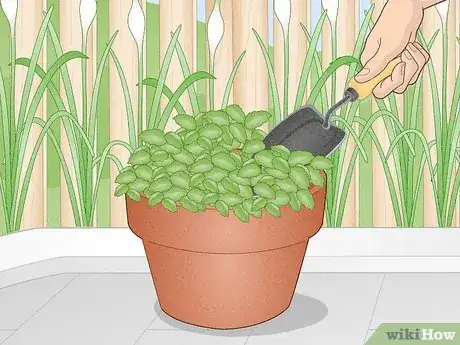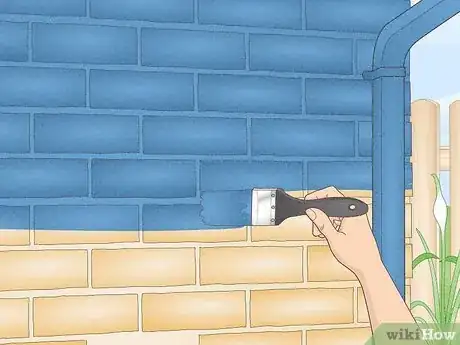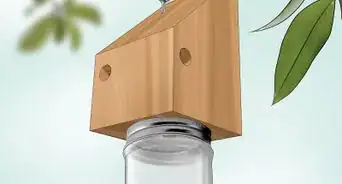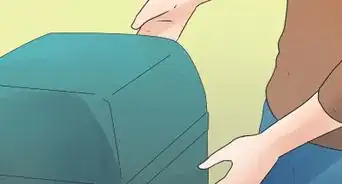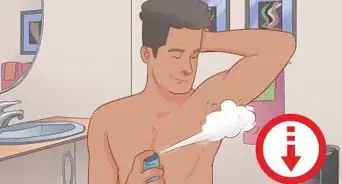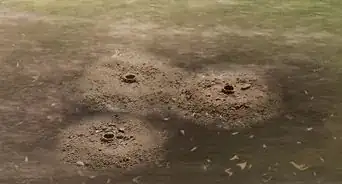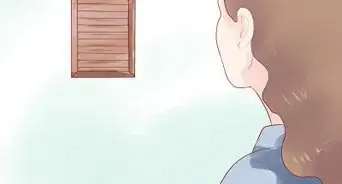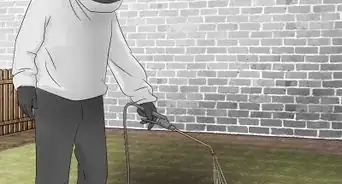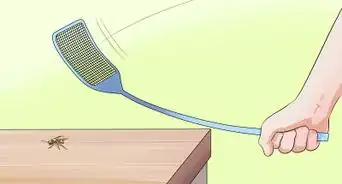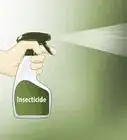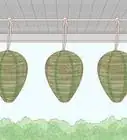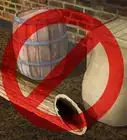This article was written by Scott McCombe and by wikiHow staff writer, Danielle Blinka, MA, MPA. Scott McCombe is the CEO of Summit Environmental Solutions (SES), a family-owned local pest solutions, animal control, and home insulation company based in Northern Virginia. Founded in 1991, SES has an A+ rating with the Better Business Bureau and has been awarded “Top Rated Professional,” and “Elite Service Award" by HomeAdvisor.
There are 8 references cited in this article, which can be found at the bottom of the page.
This article has been viewed 2,162 times.
Mud daubers aren’t dangerous, but they can be irritating and unsightly. You might not want them buzzing around your property, especially if you’re allergic to wasps. We’ll tell you everything you need to know about how to recognize mud daubers, get rid of them and their nests, and prevent them from coming back. Since they’re not aggressive, it’s really easy to remove mud daubers from your property.
This article is based on an interview with our pest control specialist, Scott McCombe. Check out the full interview here.
Things You Should Know
- Mud daubers are beneficial because they eat other pests, including black widows, and they help pollinate plants.
- You can remove mud dauber nests by scraping them off of your home. If you’re having trouble, wet the nest to soften it.
- Treating for spiders and other pests discourages mud daubers from nesting near your home because they won’t have a food source.
Steps
Identifying Mud Daubers
-
1Mud daubers are 1⁄2 to 1 in (1.3 to 2.5 cm) long and have slim bodies. Since they're narrower than other wasps, it's easy to spot them. They may be black, black and yellow, or iridescent blue.[1] They tend to live alone, and they’re most active during the summer.[2]
- Mud daubers use their stinger to paralyze prey, and they’re not aggressive. These wasps typically won’t sting you unless you handle them.
- Ground digger wasps look similar to mud daubers and are also beneficial and non-aggressive. However, they build their nests by digging a hole in dirt.
-
2Look for mud nests on the exterior of your home or on nearby trees. Mud daubers build their nests by scooping up mud and depositing it on a rough structure. Their nests may look like a tube or a clay pot with a hole on it, depending on the type of mud dauber. Only female wasps build nests because they lay their eggs inside them.[3]
- You may also find their nests on your barn, shed, or outdoor equipment.
- Some mud daubers build several nests next to each other. Usually, this is all done by one wasp who’s trying to improve her nest building skills, not several wasps.[4]
Advertisement -
3Mud daubers are beneficial and rarely sting. They kill spiders, including black widows, so they help manage the pest population. Additionally, these wasps pollinate plants, so they’re good for your garden. Since they’re not aggressive, you might decide to leave them alone.[5]
- Mud daubers are solitary wasps, so they typically live alone.
Removing the Wasp & Nest
-
1Wear long sleeves, long pants, and gloves to prevent stings. Mud daubers aren’t aggressive, but they may sting you if they feel provoked. You likely don’t need to worry because they don’t defend their nests, but it’s best to be on the safe side.[6] Put on a thick long-sleeve shirt, pants, and gardening or work gloves before you deal with the mud dauber.
-
2Spray the nest with a natural deterrent to drive away the wasp. Some essential oils and household products naturally deter mud daubers. Try these options:[7]
- Put a few drops of peppermint, chamomile, cinnamon, tea tree, or lavender oil in a spray bottle of water and spritz it onto the nest. Be careful not to get pure essential oil on your skin.
- Mix a few drops of dish soap into water in a spray bottle, then spritz it on the nest.
- Spray white vinegar on the wasp nest.
- Spray citrus oil on the nest.
-
3Use a wasp trap to catch and release the mud dauber. Fill the wasp trap with sugar water, then hang it near the nest. Wait for the wasp to wander into the trap to drink the sugar water.[8] Then, wait for the wasp to die or release it in a wooded area away from your home.
- Wasp traps are usually effective for around 3 to 4 weeks. If you’re still dealing with mud daubers after that, change out your trap.
- Other types of wasps may fly into your nest along with the mud dauber. If this happens, it might be best to let them die so you don’t risk getting stung. To quickly kill them, pour boiling water over the trap. Then, flush the wasps down the toilet so their pheromone smell won’t attract more wasps.
-
4Pour boiling water on the mud dauber. Boiling water will quickly kill the wasp without you having to use chemicals. Splash the wasp with the water, then back away. The mud dauber should die instantly.[9]
- You can also add dish soap to the boiling water to further incapacitate the wasp. If it takes a moment to die, the soap will lessen the likelihood that you'll get stung.
-
5Spray the mud dauber with insecticide to kill it. Use an aerosol spray formulated to kill wasps and hornets. Follow the instructions on the bottle to spray the wasp, then wait for it to die.[10] You likely don’t need to worry about getting stung by mud daubers, but it’s possible the wasp will get aggressive if it feels attacked.[11]
- Since mud daubers don’t defend their nests, you don’t necessarily need to kill the wasps to remove them. If you knock down the wasp’s nest, it’ll likely move on to a new spot.[12]
-
6Remove the mud dauber nest with a scraper or hose. Scrape off the nest with a putty knife. The nest may come off in one piece or in clumps of dirt.[13] If you’re having a hard time removing it, try wetting the nest to soften it.
- If you decide not to kill the mud dauber, wait until evening to remove the nest. Mud daubers are only active during the day. You could also wait until winter when mud daubers go dormant.[14]
- You may be able to wash away the nest with a power washer if it’s new. Older nests are harder to dislodge, so it’s easier to do it with a scraper.
-
7Scrub the nest area to remove any remaining dirt. Dip a cloth or sponge into warm soapy water, then scrub the area where the wasp nest used to be. Keep scrubbing until all of the dirt is gone. When you’re finished, wipe the area with a clean, damp cloth to remove any soap suds.[15]
- Try using a scrub brush with plastic bristles so it’s easier to clean off the dirt. However, don’t use a metal scrub brush because it could damage the surface.
Preventing Mud Daubers
-
1Wipe down your outdoor area to remove bugs. Get rid of the wasp’s food source by cleaning up spider webs and bugs. Use a dusting brush to clean spider webs, then thoroughly wash the area with warm, soapy water. You could also vacuum to suck up the bugs, spiders, and their webs.[16]
- If you have a lot of spiders, you might spray the area with a pesticide that kills spiders. Just make sure to wear protective eyewear, gloves, long-sleeve shirts, and pants.
-
2Repair any cracks or crevices that could attract pests. Stop spiders and other pests from moving into your home. Use caulk or foam to fill any openings in your exterior walls. Pay special attention to the area around windows and doors.
- Additionally, make sure your windows have screens so bugs can’t get inside your home.
- If there’s no food source near your home, it’ll be much less attractive to mud daubers.
-
3Put out bird seed to attract their natural predators. Birds, including black birds, eat mud daubers. To attract more birds, hang bird feeders or sprinkle bird seed in your yard. The birds can eat the adult mud daubers as they fly and may even snack on the larvae or pupae in the dirt nest.[17]
- You might not want to invite birds into your yard if you’re growing fruits and veggies because the birds will also eat your plants.
-
4Build a fake nest to deter mud daubers. Mud daubers won’t nest in another wasp’s territory. When they see a nest, they’ll fly on to another spot at least 200 feet (61 m) away. To make the nest, ball up paper and wrap it tightly in a plastic bag. Then, place the ball into a paper bag and twist it tight. Hang the fake nest in the area where you’ve seen mud dauber activity.[18]
- If you’re not crafty, you can buy a fake wasp nest to hang outside your home.
-
5Grow herbs that mud daubers don’t like. Plant eucalyptus, thyme, wormwood, citronella, or spearmint. Mud daubers and other wasps hate these plants and will typically avoid them. Add them to your garden or keep some potted herbs in your outdoor area to help get rid of mud daubers naturally.[19]
- You can also sprinkle dried herbs around your yard.
-
6Spray insecticide around your home. Choose a residual pesticide, and spray the exterior of your home as directed on the bottle. Wear personal protective gear while you apply pesticide to protect yourself. This includes pants, a long sleeve shirt, gloves, and eye protection.
- Keep children and pets away from the treated area until the pesticide dries.
-
7Paint your exterior walls blue. Prevent mud daubers from returning with the color blue. Wasps naturally avoid blue because it looks like the sky. If you need a fresh coat of paint, you might choose blue for your home’s exterior.[20]
- Alternatively, you could paint the ceiling of your porch or deck blue.
Warnings
- Keep children and pets away from areas treated with pesticide until the chemical completely dries.⧼thumbs_response⧽
- Never squash a wasp because they’ll release a pheromone that attracts other wasps to the area.[23]⧼thumbs_response⧽
References
- ↑ https://extension.umn.edu/yard-and-garden-insects/solitary-wasps
- ↑ https://backyardbuddies.org.au/backyard-buddies/mud-wasps/
- ↑ https://backyardbuddies.org.au/backyard-buddies/mud-wasps/
- ↑ https://backyardbuddies.org.au/backyard-buddies/mud-wasps/
- ↑ https://extension.entm.purdue.edu/publications/E-253/E-253.html
- ↑ http://extension.msstate.edu/newsletters/bug%E2%80%99s-eye-view/2020/organ-pipe-mud-dauber-vol-6-no-20
- ↑ https://www.welllivingideas.com/11-natural-ways-to-get-rid-of-mud-daubers-and-their-nest/
- ↑ https://www.welllivingideas.com/11-natural-ways-to-get-rid-of-mud-daubers-and-their-nest/
- ↑ https://www.welllivingideas.com/11-natural-ways-to-get-rid-of-mud-daubers-and-their-nest/
- ↑ https://extension.entm.purdue.edu/publications/E-253/E-253.html
- ↑ https://backyardbuddies.org.au/backyard-buddies/mud-wasps/
- ↑ https://extension.umn.edu/yard-and-garden-insects/solitary-wasps
- ↑ https://extension.entm.purdue.edu/publications/E-253/E-253.html
- ↑ https://ucanr.edu/blogs/blogcore/postdetail.cfm?postnum=28834
- ↑ https://extension.entm.purdue.edu/publications/E-253/E-253.html
- ↑ https://ucanr.edu/blogs/blogcore/postdetail.cfm?postnum=28834
- ↑ https://entnemdept.ufl.edu/creatures/MISC/WASPS/Sceliphron_caementarium.htm
- ↑ https://plantcaretoday.com/natural-ways-get-rid-wasps.html
- ↑ https://www.welllivingideas.com/11-natural-ways-to-get-rid-of-mud-daubers-and-their-nest/
- ↑ https://plantcaretoday.com/natural-ways-get-rid-wasps.html
- ↑ https://plantcaretoday.com/natural-ways-get-rid-wasps.html
- ↑ https://plantcaretoday.com/natural-ways-get-rid-wasps.html
- ↑ https://www.welllivingideas.com/11-natural-ways-to-get-rid-of-mud-daubers-and-their-nest/
